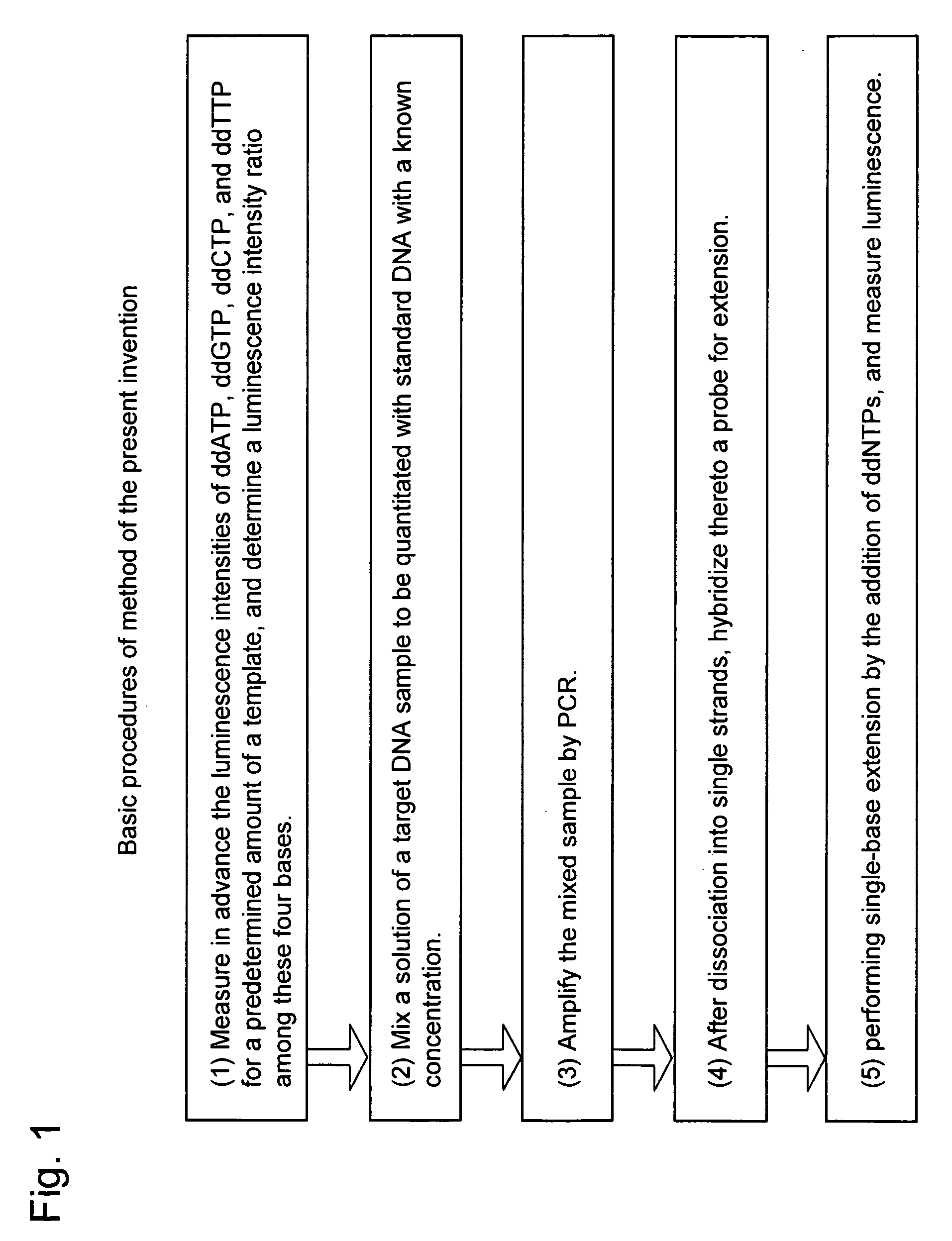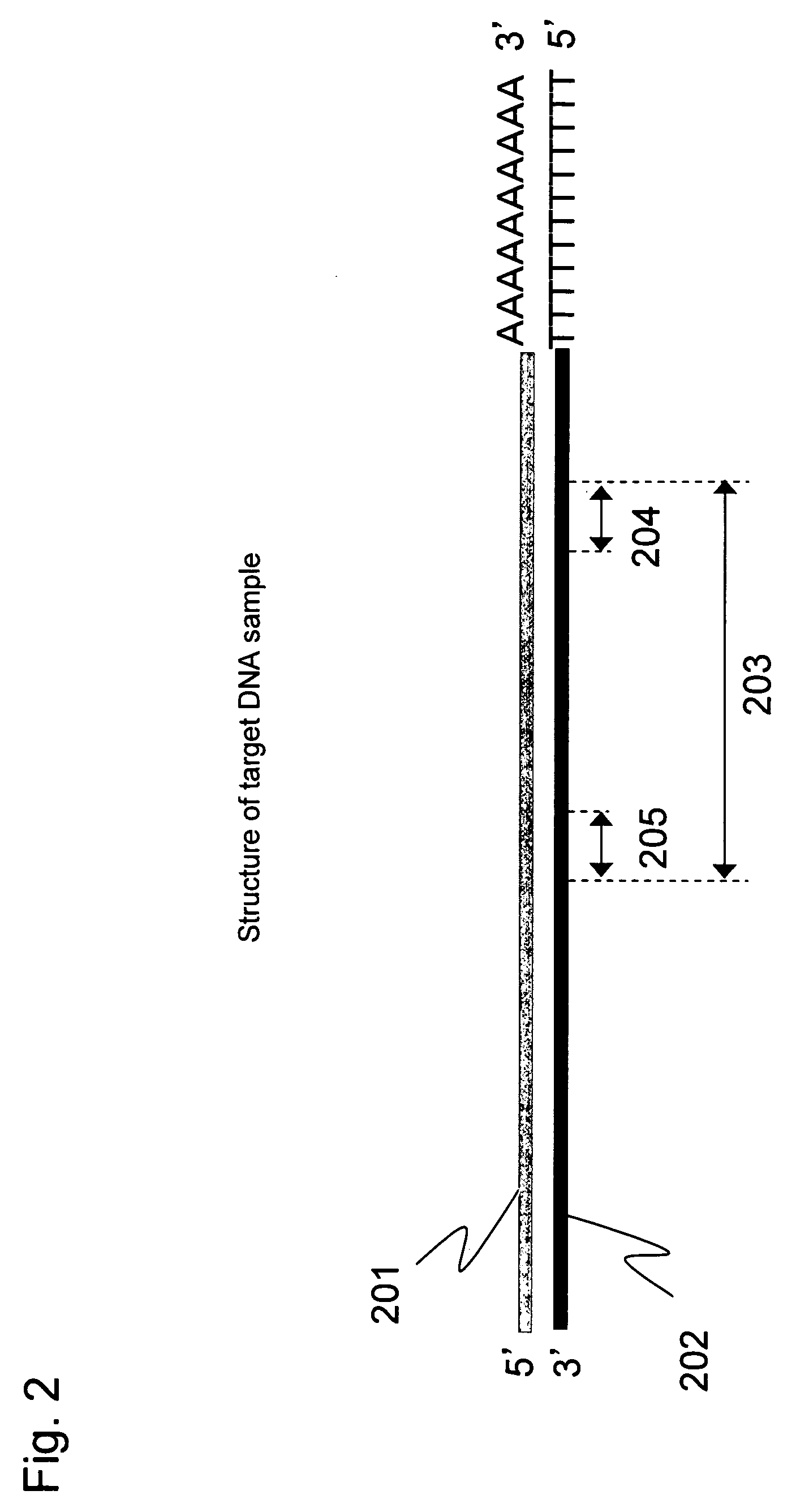Method for nucleic acid quantitation
- Summary
- Abstract
- Description
- Claims
- Application Information
AI Technical Summary
Benefits of technology
Problems solved by technology
Method used
Image
Examples
example 1
[0056]Example 1 shows the quantitation of an expression level of EFF1G gene in human colon cancer cells (HCT116).
[0057]Full-length cDNA (202) containing a target region was prepared from human colon cancer mRNA (201) according to Step 1 described below. This long cDNA contains a DNA sequence region (203) to be analyzed as a target for quantitative analysis. The target sequence is represented by SEQ ID NO: 1 shown in Sequence Listing. This sequence comprises a priming site of a reverse primer (204), the amplification region to be analyzed (203), and a priming site of a forward primer (205), as schematically shown in FIG. 2.
[0058]A portion of the cDNA sample was collected, and a single-stranded DNA fragment having the same sequence as that of the target except for a single-base substitution portion was prepared according to Step 2. In the present Example, the forward primer was designed such that its sequence contained a substitution portion at the 7th base position from the 3′ end. O...
example 2
[0070]Example 2 shows the quantitation of a target DNA sample obtained by reverse transcription of mRNA on oligo(dT)30 magnetic beads.
[0071]An expression level of EFF1G gene in human colon cancer cells (HCT116) was quantitated in the same way as in Example 1. In the present Example, RNA prepared from the colon cancer cells according to the Step 1 is a starting material. cDNA was prepared using oligo(dT)30-immobilized magnetic beads prepared according to Step 6. The cDNA was prepared according to Step 7. Three standard DNA samples were prepared according to the Step 2. These standard DNA samples were mixed at different proportions with the target DNA sample, and the mixed sample was amplified by PCR using the same primers according to Step 8. This amplification product was dissociated into single strands according to the Step 4 of Example 1. Luminescence attributed to single-base extension was measured according to the Step 5 to perform the quantitative analysis of the target DNA sam...
example 3
[0075]Example 3 shows the quantitation of an expression level of EFF1G gene in human colon cancer cells (HCT116) by reusing cDNA immobilized on magnetic beads.
[0076]When a target to be analyzed is obtained in the form of single-stranded cDNA immobilized on magnetic beads as shown in Example 2, the immobilized cDNA is used as a template for 2nd-strand cDNA synthesis. After removal of primers, etc., the synthesized complementary strand is released into a solution and may be used as a target for quantitative analysis. Three standard DNAs (Step 2 of Example 1) are added at different proportions to the synthesized complementary strand sample, and this mixed sample is amplified by PCR using the same primers. The primer used in this PCR amplification is designed to hybridize to the terminal side from the single-base substitution site introduced in the standard DNAs. Therefore, the target DNA sample and the standard DNAs have completely the same application efficiency, as in Examples 1 and ...
PUM
| Property | Measurement | Unit |
|---|---|---|
| Concentration | aaaaa | aaaaa |
Abstract
Description
Claims
Application Information
 Login to View More
Login to View More - R&D
- Intellectual Property
- Life Sciences
- Materials
- Tech Scout
- Unparalleled Data Quality
- Higher Quality Content
- 60% Fewer Hallucinations
Browse by: Latest US Patents, China's latest patents, Technical Efficacy Thesaurus, Application Domain, Technology Topic, Popular Technical Reports.
© 2025 PatSnap. All rights reserved.Legal|Privacy policy|Modern Slavery Act Transparency Statement|Sitemap|About US| Contact US: help@patsnap.com



